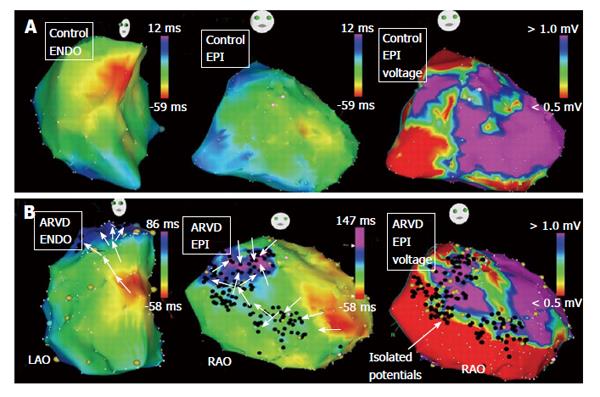Copyright
©2014 Baishideng Publishing Group Inc.
World J Cardiol. Sep 26, 2014; 6(9): 959-967
Published online Sep 26, 2014. doi: 10.4330/wjc.v6.i9.959
Published online Sep 26, 2014. doi: 10.4330/wjc.v6.i9.959
Figure 4 Right ventricle endocardial and epicardial activation maps and epicardial bipolar voltage maps of a control patient (A) and a patient with arrhythmogenic right ventricular cardiomyopathy/dysplasia (B) are shown.
A: From control patient demonstrates continuous and rapid activation from the anteroseptal region toward the infundibulum and tricuspid annulus. The endocardial (not shown) and epicardial voltage map did not reveal any late potential or substantive voltage abnormalities; B: From patient with ARVC/D demonstrates significant epicardial scarring with epiendo isolated late potentials (black tags) on the bipolar voltage map. The activation wavefront is significantly delayed into the scar due to the extensive epicardial disease. Adapted from Haqqani et al[18] with permission. RAO: Right anterior oblique; LAO: Left anterior oblique.
- Citation: Tschabrunn CM, Marchlinski FE. Ventricular tachycardia mapping and ablation in arrhythmogenic right ventricular cardiomyopathy/dysplasia: Lessons Learned. World J Cardiol 2014; 6(9): 959-967
- URL: https://www.wjgnet.com/1949-8462/full/v6/i9/959.htm
- DOI: https://dx.doi.org/10.4330/wjc.v6.i9.959









